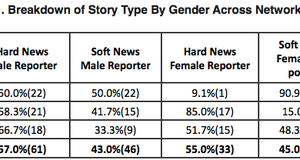|
From Elon Journal of Undergraduate Research in Communications VOL. 5 NO. 1 Revolutionizing the Newsroom: How Online and Mobile Technologies Have Changed Broadcast Journalism
By Nicole Chadwick
Elon Journal of Undergraduate Research in Communications
2014, Vol. 5 No. 1 | pg. 3/3 | «
The television news industry has been transformed to integrate online and mobile channels into the traditional on-air channel. New job descriptions provide new opportunities for journalists, like one-man bands, with a variety of skills. To provide news, broadcast professionals search for content through the Internet on a daily basis. The Internet and mobile devices have already changed the newsroom by introducing new ways to connect with viewers and to communicate with other journalists within the work place. Being online has become a part of daily life for many people of the United States, and television news has taken a new position within a new digital landscape. As viewers continue to access content online and through mobile devices, television journalists must exploit a variety of technologies available to satisfy consumption patterns. If the definition of news is expanded by embracing everything from long form broadcast stories to one hundred and forty characters of text, it will create a new lucrative business model. Television news will continue to exist and thrive, but only if journalists continue to embrace changing technology as they have in the past century.
Some of the limitations of this study include concerns for external validity, or the generalizability of the study. Expanding the sample of this study to include more journalists across the United States would have given a more comprehensive understanding of the relationship between technology and television journalism. However, due to the qualitative nature of the research and limited time for the study, only thirteen journalists could be interviewed. These research subjects were selected based on personal relationships with the author through internships at CBS News’s 60 Minutes, CBS Sunday Morning, WFAA-TV, and experience at Elon University student media organizations, including Elon Local News and Phoenix14 News.
This author would like to thank Dr. David Copeland for his kindness, devoted work and thoughtful guidance, without which the article could not be published. The author also appreciates numerous reviewers who have helped revise this article.
Bardoel, Jo, Deuze, Mark, “Network Journalism: Converging Competences of Media Professionals and Professionalism,” Australian Journalism Review (2001): 23 pp.91-103.
Deuze, Mark, “Online Journalism: Modeling the first generation of news media on the world wide web” Peer Reviewed Journal on the Internet (2001).
Dooley, Patricia. The Technology of Journalism: Cultural Agents, Cultural Icons (Northwestern University: Northwestern University Press, 2007).
Giles, Robert and Snyder, Robert W. Problems & Prospects of Journalism: What’s Next? (New Brunswick: Transaction Publishers, 2001).
Jenkins, Henry. “Convergence: I Diverge.” MIT Technology Review, June 1, 2001.
Jurkowitz, Mark and Matsa, Katerina Eva, “Despite Some Warning Signs, Local TV Stations Are Hot Commodities,” Pew Research Journalism Project, August 5, 2013, accessed October 15, 2013, http://www.journalism.org/2013/08/05/despite-some-warning-signs-local-tv-stations-are-hot-commodities/
Nguyen, An “The current status and potential development of online news consumption: a structural approach” First Monday, 2001, http://firstmonday.org/ojs/index.php/fm/article/view/1075/995(October 15, 2013)
Sasseen, Jane, Olmstead, Kenny, and Mitchell, Amy “Digital: As Mobile Grows Rapidly, the Pressures on News Intensify,” The State of the News Media 2013, accessed October 15, 2013, http://stateofthemedia.org/2013/digital-as-mobile-grows-rapidly-the-pressures-on-news-intensify/
- Patricia L. Dooley, The Technology of Journalism: Cultural Agents, Cultural Icons (Northwestern University: Northwestern University Press, 2007). 1.
- Giles, Snyder, What’s Next?, xi.
- Susan Zirinksy, Executive Producer, 48 Hours, in a telephone interview with the author, November 1, 2013.
- Mark Effron, “Broadcast Journalism Not Dead, Just Changing,” TV Week, 2010, http://www.tvweek.com/news/2008/07/guest_commentary_broadcast_jou.php (November 12, 2013).
- John Naughton, A Brief History of the Future: The Origins of the Internet (Great Britain: Weidenfeld & Nicolson, 1999), 22.
- Jo Bardoel and Mark Deuze, “Network Journalism: Converging Competences of Media Professionals and Professionalism,” Australian Journalism Review (2001), 23.
- Mark Deuze, “Online Journalism: Modeling the first generation of news media on the world wide web” First Monday (2001).
- Henry Jenkins, “Convergence: I Diverge.” MIT Technology Review, June 1, 2001
- Robert Giles and Robert W. Snyder, Problems & Prospects of Journalism: What’s Next? (New Brunswick: 2001), xi.
- Mark Jurkowitz and Katerina Eva Matsa, “Despite Some Warning Signs, Local TV Stations Are Hot Commodities,” Pew Research Journalism Project, August 5, 2013 http://www.journalism.org/2013/08/05/despitesome-warning-signs-local-tv-stations-are-hot-commodities/ (October 15, 2013).
- Jane Sasseen, Kenny Olmstead, and Amy Mitchell,“Digital: As Mobile Grows Rapidly, the Pressures on News Intensify,” The State of the News Media 2013, 2013, http://stateofthemedia.org/2013/digital-as-mobilegrows-rapidly-the-pressures-on-news-intensify/, (October 15, 2013).
- Dapzury Valenzuela and Pallavi Shrivastava, Interview as a Method for Qualitative Research, Southern Cross University and the Southern Cross Institute of Action Research.
- Steinar Kvale, InterViews: An Introduction to Qualitative Research Interviewing, Sage Publications, 1996.
- Matt Howerton, in a Facebook message to the author, October 16, 2013.
- Drew Smith, reporter in an email message to the author, October 19, 2013.
- Reporters write the stories for the newscast including parts of interviews and research into their content. Also see one-man band.
- Print style is a form of writing an article that is written generally for the web or for a newspaper in Associated Press style.
- Janet St. James, in an email message to the author, October 17, 2013
- Nick Ochsner, in a Facebook message to the author, October 16, 2013.
- Monica Yantosh, in a Facebook message to the author, November 5, 2013.
- Producers work with reporters, associate producers, and the executive producers to write and put together content for individual stories and/or for a cohesive newscast.
- B-roll is the supplemental or alternate footage intercut with the main shot in an interview or documentary.
- Andy Merlis, in an email message to the author, October 21, 2013.
- Cathy Lewis, in an email message to the author, October 31, 2013.
- Meggie Miao, in an email message to the author, October 23, 2013.
- Kenneth Olmstead, Mark Jurkowitz, Amy Mitchell and Jodi Enda, “How Americans Get TV News at Home,” Pew Research Journalism Project, 2013, November 10, 2013.
- Zirinsky, telephone conversation with the author.
- Shelly Slater, in an email message to the author, October 22, 2013.
- Amy Mitchell, Jocelyn Kiley, Jeffrey Gottfried and Emily Guskin, “The Role of News on Facebook: Common yet Incidental,” Pew Journalism Project, 2013, http://www.journalism.org/2013/10/24/the-role-of-news-onfacebook/, (November 10, 2013).
- Sasseen, Olmstead, and Mitchell, The State of the News Media 2013, 2013.
- Howerton, Facebook message to the author.
- Ochsner, Facebook message to the author.
- St. James, email to the author.
- Merlis, email to the author.
- Smith, Facebook message to the author.
- One-man-band journalists are journalists that write their own content, do their own research, and shoot and edit their own video for the air.
- Deborah Potter, Katerina-Eva Matsa and Amy Mitchell, “Local TV: Audience Declines as Revenue Bounces Back,” The State of the News Media 2013, 2013.
- Howerton, Facebook message to the author.
- Yantosh, Facebook message to the author.
- Slater, email to the author.
- Samuels, email to the author.
- Lewis, email to the author.
- Smith, Facebook message to the author.
- Yantosh, Facebook message to the author.
- Boyd, Facebook message to the author.
- Howerton, Facebook message to the author.
- Lewis, email to the author.
- Zirinsky, telephone conversation with the author.
- Miao, email to the author.
- Zirinsky, telephone conversation with the author.
- Slater, email to the author.
- Zirinsky, telephone conversation with the author.
- Ochsner, Facebook message to the author.
Bardoel, Jo, Deuze, Mark, “Network Journalism: Converging Competences of Media Professionals and Professionalism,” Australian Journalism Review (2001): 23 pp.91-103.
Deuze, Mark, “Online Journalism: Modeling the first generation of news media on the world wide web” Peer Reviewed Journal on the Internet (2001).
Dooley, Patricia. The Technology of Journalism: Cultural Agents, Cultural Icons (Northwestern University: Northwestern University Press, 2007).
Giles, Robert and Snyder, Robert W. Problems & Prospects of Journalism: What’s Next? (New Brunswick: Transaction Publishers, 2001).
Jenkins, Henry. “Convergence: I Diverge.” MIT Technology Review, June 1, 2001.
Jurkowitz, Mark and Matsa, Katerina Eva, “Despite Some Warning Signs, Local TV Stations Are Hot Commodities,” Pew Research Journalism Project, August 5, 2013, accessed October 15, 2013, http://www.journalism.org/2013/08/05/despite-some-warning-signs-local-tv-stations-are-hot-commodities/
Nguyen, An “The current status and potential development of online news consumption: a structural approach” First Monday, 2001, http://firstmonday.org/ojs/index.php/fm/article/view/1075/995(October 15, 2013)
Sasseen, Jane, Olmstead, Kenny, and Mitchell, Amy “Digital: As Mobile Grows Rapidly, the Pressures on News Intensify,” The State of the News Media 2013, accessed October 15, 2013, http://stateofthemedia.org/2013/digital-as-mobile-grows-rapidly-the-pressures-on-news-intensify/
Endnotes
- Patricia L. Dooley, The Technology of Journalism: Cultural Agents, Cultural Icons (Northwestern University: Northwestern University Press, 2007). 1.
- Giles, Snyder, What’s Next?, xi.
- Susan Zirinksy, Executive Producer, 48 Hours, in a telephone interview with the author, November 1, 2013.
- Mark Effron, “Broadcast Journalism Not Dead, Just Changing,” TV Week, 2010, http://www.tvweek.com/news/2008/07/guest_commentary_broadcast_jou.php (November 12, 2013).
- John Naughton, A Brief History of the Future: The Origins of the Internet (Great Britain: Weidenfeld & Nicolson, 1999), 22.
- Jo Bardoel and Mark Deuze, “Network Journalism: Converging Competences of Media Professionals and Professionalism,” Australian Journalism Review (2001), 23.
- Mark Deuze, “Online Journalism: Modeling the first generation of news media on the world wide web” First Monday (2001).
- Henry Jenkins, “Convergence: I Diverge.” MIT Technology Review, June 1, 2001
- Robert Giles and Robert W. Snyder, Problems & Prospects of Journalism: What’s Next? (New Brunswick: 2001), xi.
- Mark Jurkowitz and Katerina Eva Matsa, “Despite Some Warning Signs, Local TV Stations Are Hot Commodities,” Pew Research Journalism Project, August 5, 2013 http://www.journalism.org/2013/08/05/despitesome-warning-signs-local-tv-stations-are-hot-commodities/ (October 15, 2013).
- Jane Sasseen, Kenny Olmstead, and Amy Mitchell,“Digital: As Mobile Grows Rapidly, the Pressures on News Intensify,” The State of the News Media 2013, 2013, http://stateofthemedia.org/2013/digital-as-mobilegrows-rapidly-the-pressures-on-news-intensify/, (October 15, 2013).
- Dapzury Valenzuela and Pallavi Shrivastava, Interview as a Method for Qualitative Research, Southern Cross University and the Southern Cross Institute of Action Research.
- Steinar Kvale, InterViews: An Introduction to Qualitative Research Interviewing, Sage Publications, 1996.
- Matt Howerton, in a Facebook message to the author, October 16, 2013.
- Drew Smith, reporter in an email message to the author, October 19, 2013.
- Reporters write the stories for the newscast including parts of interviews and research into their content. Also see one-man band.
- Print style is a form of writing an article that is written generally for the web or for a newspaper in Associated Press style.
- Janet St. James, in an email message to the author, October 17, 2013
- Nick Ochsner, in a Facebook message to the author, October 16, 2013.
- Monica Yantosh, in a Facebook message to the author, November 5, 2013.
- Producers work with reporters, associate producers, and the executive producers to write and put together content for individual stories and/or for a cohesive newscast.
- B-roll is the supplemental or alternate footage intercut with the main shot in an interview or documentary.
- Andy Merlis, in an email message to the author, October 21, 2013.
- Cathy Lewis, in an email message to the author, October 31, 2013.
- Meggie Miao, in an email message to the author, October 23, 2013.
- Kenneth Olmstead, Mark Jurkowitz, Amy Mitchell and Jodi Enda, “How Americans Get TV News at Home,” Pew Research Journalism Project, 2013, November 10, 2013.
- Zirinsky, telephone conversation with the author.
- Shelly Slater, in an email message to the author, October 22, 2013.
- Amy Mitchell, Jocelyn Kiley, Jeffrey Gottfried and Emily Guskin, “The Role of News on Facebook: Common yet Incidental,” Pew Journalism Project, 2013, http://www.journalism.org/2013/10/24/the-role-of-news-onfacebook/, (November 10, 2013).
- Sasseen, Olmstead, and Mitchell, The State of the News Media 2013, 2013.
- Howerton, Facebook message to the author.
- Ochsner, Facebook message to the author.
- St. James, email to the author.
- Merlis, email to the author.
- Smith, Facebook message to the author.
- One-man-band journalists are journalists that write their own content, do their own research, and shoot and edit their own video for the air.
- Deborah Potter, Katerina-Eva Matsa and Amy Mitchell, “Local TV: Audience Declines as Revenue Bounces Back,” The State of the News Media 2013, 2013.
- Howerton, Facebook message to the author.
- Yantosh, Facebook message to the author.
- Slater, email to the author.
- Samuels, email to the author.
- Lewis, email to the author.
- Smith, Facebook message to the author.
- Yantosh, Facebook message to the author.
- Boyd, Facebook message to the author.
- Howerton, Facebook message to the author.
- Lewis, email to the author.
- Zirinsky, telephone conversation with the author.
- Miao, email to the author.
- Zirinsky, telephone conversation with the author.
- Slater, email to the author.
- Zirinsky, telephone conversation with the author.
- Ochsner, Facebook message to the author.
Save Citation » (Works with EndNote, ProCite, & Reference Manager)
APA 6th
Chadwick, N. (2014). "Revolutionizing the Newsroom: How Online and Mobile Technologies Have Changed Broadcast Journalism." Elon Journal of Undergraduate Research in Communications, 5(1). Retrieved from http://www.inquiriesjournal.com/a?id=969
MLA
Chadwick, Nicole. "Revolutionizing the Newsroom: How Online and Mobile Technologies Have Changed Broadcast Journalism." Elon Journal of Undergraduate Research in Communications 5.1 (2014). <http://www.inquiriesjournal.com/a?id=969>
Chicago 16th
Chadwick, Nicole. 2014. Revolutionizing the Newsroom: How Online and Mobile Technologies Have Changed Broadcast Journalism. Elon Journal of Undergraduate Research in Communications 5 (1), http://www.inquiriesjournal.com/a?id=969
Harvard
CHADWICK, N. 2014. Revolutionizing the Newsroom: How Online and Mobile Technologies Have Changed Broadcast Journalism. Elon Journal of Undergraduate Research in Communications [Online], 5. Available: http://www.inquiriesjournal.com/a?id=969
Suggested Reading from Inquiries Journal
Recent advancements in digital media have had drastic effects on magazines across the country. This research paper addressed those results by examining the digital and social media practices of four city magazines based in the American Southeast to determine what practices are working across social media and digital platforms. Through... MORE»
Twitter. Facebook. Digg. MySpace. LinkedIn. The list of social media tools could probably run on for paragraphs, and today’s technology changes so rapidly that many industries, including corporations and news media... MORE»
This study, conducted during a two-week period leading up to the 2012 Presidential Election, analyzed three prime time news broadcasts to determine whether male journalists reported more hard news stories than female journalists throughout a segment of increased political activity and whether male and female sources were used equally... MORE»
The simplistic history of modern journalism commonly disseminated in western classrooms describes literary journalism and its manifestations around the world as traceable back to a single Anglo-American tradition —... MORE»
Latest in Business & Communications
2021, Vol. 13 No. 09
This research lies at the nexus of political communication theory relating to emotional affect and political processing and the burgeoning field of sentiment analysis. News coverage can affect opinion both through the information it provides and... Read Article »
2021, Vol. 13 No. 06
This research study explores factors that present barriers to reporting workplace incidents and contribute to cultures of non-report. The research purpose was to explore human, workplace/organizational, and external factors identified by industrial... Read Article »
2016, Vol. 8 No. 11
In its beta release, Google Glass was positioned as a groundbreaking technology - a glimpse into a future that has long been promised in science fiction. It was met with media fanfare and consumer interest, despite costing more than most PCs on... Read Article »
2016, Vol. 7 No. 1
Predicting the future of the news industry begins with understanding the history of newspapers and the current news delivery landscape. Because the Internet has brought fundamental shifts to news distribution, successful organizations of the future... Read Article »
2016, Vol. 7 No. 1
Instagram allows users to share a snapshot of their lives with a mass audience in a matter of seconds. This capability and power has not gone unnoticed by celebrities, who are highly aware of the impact their social media accounts have on fans and... Read Article »
2016, Vol. 7 No. 1
Since its development, YouTube, the world's third most popular online destination, has transformed from a video-sharing site into a job opportunity for content creators in both new and mainstream media. Based on content analysis, the study examined... Read Article »
2016, Vol. 7 No. 1
Today, more than 15 million Americans practice yoga, making the ancient Indian discipline synonymous with the Western society's culture of wellness. As a way to market themselves, practitioners and instructors of yoga have utilized Instagram &ndash... Read Article »
|




















